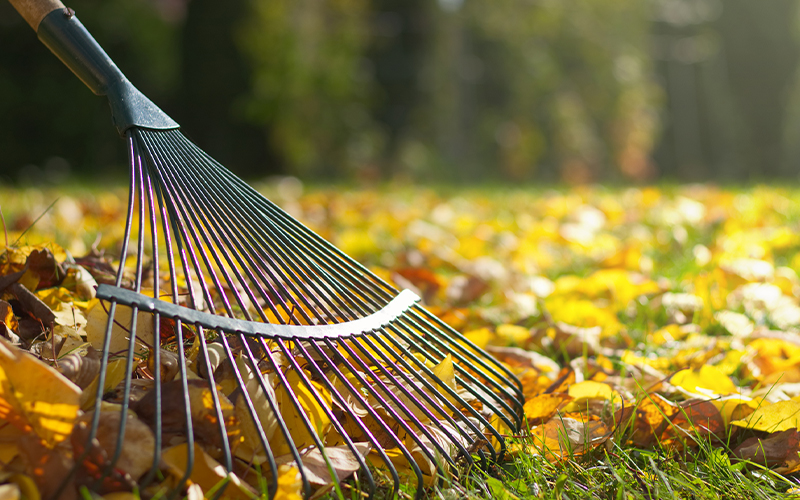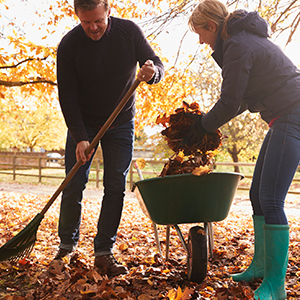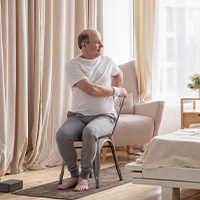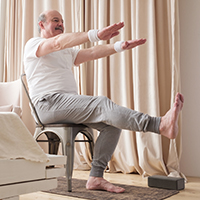Take Care When Raking Leaves

Whether you love or loathe the fall clean-up process, raking leaves is a very demanding chore. One you should perform with as much caution as running, skiing, and other vigorous activities.
Raking is serious work

While it may seem simple, raking leaves can be physically stressful, even for people who exercise routinely. The repetitive motions coupled with repeated bending, reaching, twisting, lifting, and carrying can easily lead to a pulled or torn muscle or worse. These strains often occur in the shoulders, arms, and neck. Especially if you don't regularly exercise these areas.
“Injuries from repetitive movements are a very common occurrence,” says physical therapist Allyson Klug, PT, DPT, of Mary Free Bed at Munson Healthcare. “A repetitive strain injury is damage to your muscles, tendons, or even your nerves caused by repetitive motions and continuous use.”
So what can you do to avoid soreness and injuries? Most raking injuries are related to incorrect technique and overuse of a muscle. But the majority of raking injuries can be prevented!
Safe-Raking Tips
Rethink raking altogether if you have a history of problems related to your heart, lungs, bones, joints, or spine. And if you’re hesitant to take on this strenuous yardwork for any other reason, it’s imperative to talk to your primary care physician before moving forward.
If you feel comfortable raking or have clearance from your family provider, follow our tips below to avoid soreness and injury.
1. Warm up your muscles
Remember to treat raking just like you would any other high-intensity exercise – and that means warming up before you start.
“Raking is a lot of trunk movement, so warming up your spine with some gentle rotations and extension will do you good!” shares Klug.
Klug’s suggested stretches include:
Trunk
Seated Thoracic Rotations

Begin sitting upright in a chair with your arms crossed over your chest. Turn your shoulders and upper back, as if you’re trying to look behind you. Hold for 3 seconds before slowly moving in the opposite direction. Repeat this ten times on each side.
Seated Thoracic Extension
Sit straight up in a chair. Clasp hands behind your head, elbows out. Extend from the upper back as much as you can while keeping your low back against the chair. Hold for 5-10 seconds, repeating 5-10 times.
Upper Body
Cross body arm stretch

Bring one arm across your chest. Apply pressure gently above your elbow for a deeper stretch. Hold 30 seconds then switch.
Corner pec stretch

Stand at a corner of a wall, placing your arms on the walls with elbows bent so your upper arms are horizontal and your forearms are directed upwards as shown. Take one step forward towards the corner. Bend your front knee until you feel a stretch along the front of your chest and/or shoulders. Repeat 2x for 30 seconds.
Legs
High kicks

Using the muscles on the front of your thigh, kick your leg forward, keeping your knee straight, until you feel a stretch on the back of your thigh. Reach with your opposite arm to the kicking foot. Repeat with other leg and arm 10 times each.
2. Choose rake-ready gear
Clothing
Wear sturdy, slip-resistant shoes. Gloves too can help you maintain a more consistent grip. They’ll also prevent skin chaffing and painful blisters that can form on your hands as well.
Tools

Not all rakes are equal. The right rake can make a big difference in how efficiently you work – and how you feel during and after raking. Make sure your rake meets the following criteria:
- The correct height (not too short)
- Lightweight (not too heavy)
- Good working condition (a worn-out rake means extra effort, which can lead to injury)
- Feels comfortable in your grip
3. Watch your posture
- ✓ Stand up straight as you rake, bending from your knees as needed.
- ✓ Focus on shorter strokes that won’t cause you to twist too much or overextend.
- ✓ Switch sides every few minutes to give your arms and legs a break.
- ✓ Squat (vs bend) to lift heavy items, such as leaves, bags, or equipment.
- ✓ Lift only as much as you can comfortably carry
- ✓ Remember: It’s not a race.
4. Take your time
Plan ahead so you don’t feel like you have to race against time to clean up your yard before the snow flies. This might mean raking for 10-30 minutes a day rather than tackling the whole yard in one afternoon. If you end up working longer than you planned, take breaks to give your body a rest – and don’t forget to hydrate!
5. Ask for help

If you have a large yard or you need help with certain tasks like picking up piles or moving your leaf bags curbside, ask for help.
If you have older loved ones or neighbors, offer your help so they don’t go it alone. Consider hiring a professional if you don’t feel equipped to handle it all.
6. Cool down
Before you sit down to rest and hydrate, do some more stretching to release tension and avoid tight muscles.
Do You Have Ongoing Joint Pain?
If persistent pain in your shoulders, knees, hips, and/or other joints is keeping you from your everyday activities, Munson Healthcare Orthopedic Institute (MOI) can help. Our fellowship-trained orthopedic experts each specialize in a specific joint, so you can work with a provider who specializes specifically in your area of concern.
Suggested blogs:
- Could It Be Prostate Cancer?
- The Long-Term Health Effects of COVID-19
- Do Flu Shots Really Work?
- Crunchy Pumpkin Pie: Delicious, Seasonal Recipes